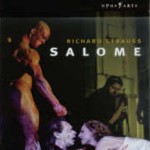I always approach a David McVicar production with interest and occasionally with caution; he’s never dull or foolish and he frequently finds a new nail to hit squarely on the head. This was certainly true of his Giulio Cesare for Glyndebourne and recent Marriage of Figaro at the Royal Opera House; somewhat less so for his Manon for the Liceu. In this new Salome, premiered at Covent Garden just last February (2008), McVicar takes as his point of reference Pasolini’s grime-pit of a movie, Salò, which itself was based on the Marquis de Sade’s 1785 novel, The 120 Days of Sodom. Set in the 1930s, it is a world in which fascism and sadism go hand-in-hand.
Designer Es Devlin has supplied McVicar with a filthy-looking set on two levels connected by a spiral staircase, although we cannot see much of the upper level–just well-dressed people, including soldiers, businessmen, elegant women, at a long table having dinner. But all the action takes place downstairs in a tiled space that is a combination sewer, kitchen, abattoir, bathroom (there are urinals at one end); it is lit in an otherworldly pale blue and pink.
Armed soldiers and naked and partially naked women come and go in thought-free debauchery, while silent liveried servants cater to their every need. The executioner is on stage from the start, sword in hand. After dinner, Herod brings the party downstairs to join this odd combo of people in this unappealing place. There is no moral order and nobody ever shows emotion except for the screaming Herod, peacock-proud Herodias, and, of course, Salome.
Because early in the opera Salome promises Narraboth a green flower, and David McVicar tells us in the accompanying booklet that in Victorian England a green carnation symbolized homosexuality (and Wilde would, of course, have been aware of this), he therefore asks for a “re-interpretation” of Salome as a masculine figure. This is the kind of thought that should have shown up in an “Aha!” moment and then been dismissed, but unfortunately it was not.
For the Dance of the Seven Veils, the stage goes dark and scenery disappears, creating a dream-sequence/memory/fantasy where we see Salome as a little girl (or boy?) being molested by Herod; he forces her to try on different fancy gowns in seven different rooms. A sink is wheeled onstage and Salome, lurching, uses water to cleanse Herod from her. The dance ends and she winds up in a white slip, back in the tiled room, looking as if she’s just vomited. And the fact that Herod has some sort of “personal” relationship with a scruffy-looking, cowering kitchen boy presumably adds to the sexual ambiguity. Does this mean, as McVicar suggests, that we must rethink Salome’s relationship with Jokanaan as well? Too many ideas, and Strauss’ Salome is in danger of getting lost–thoughtful but misleading, at best.
After the dance, back to Salome as we know it: The executioner, stripped naked by Herodias (fortunately, he was only wearing a military coat), goes down to the cistern, returns covered head-to-toe in blood, Salome sings, kisses, caresses, rolls around and bathes in blood, and the executioner tosses her like a rag doll and breaks her neck. With all the obvious thought that has gone into this production (and a bonus CD fascinatingly takes us through the entire process, from conception to first night, with McVicar and the entire team) I remain amazed at how unaffected I felt at its close. It’s normally a sure-fire work for me.
I must admit that I had just seen Karita Mattila’s Salome at the Met in a performance of such vocal strength and psychological depth that it would be hard to beat; but objectively, in addition to McVicar’s distancing us from the drama by making so many statements, the singing on this DVD is not very appealing. Best is Michael Volle’s Jokanaan, a dirty, hairy figure who seems to be in spasm part of the time, and who booms forth like the voice of God he’s supposed to be. An enormous performance. Then we skip to Joseph Kaiser’s Narraboth, sung as if it were a Mozart role, filled with caressing, imploring tones. Nothing is wrong with Thomas Moser’s singing as Herod except that it is ugly and relentlessly loud; he’s a nasty, bluff, Big Daddy in a tuxedo, more of a caricature than usual. Michaela Schuster also is big and blowsy as Herodias, and utterly delighted with her daughter’s behavior.
Nadja Michael, easy on the eye, sings Salome with such sincerity, passion, and commitment that you want to be bowled over. She wisely sings pianissimo for all but the big climaxes, and is very effective doing so. But the big moments are many and crucial and she is so often off-key that it is alarming and eventually very unsatisfying. Philippe Jordan leads with Michael’s voice in mind, emphasizing the exotic, tinkly aspects of the score rather than the dissonances and explosions. In the long run, it’s too gentle a reading to do Strauss justice. The sound and picture are superb, but because the entire width of the stage is used (and to excellent effect) we can rarely see it all at once. In all, even with a stronger singer in the title role this seems to be a misguided production.
































